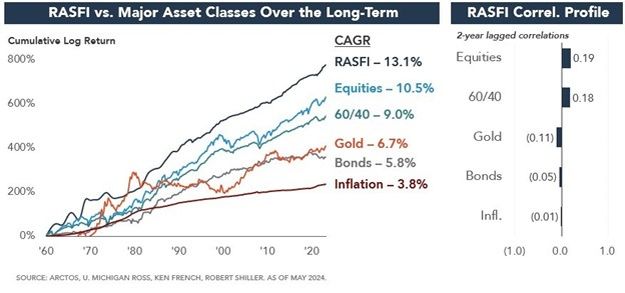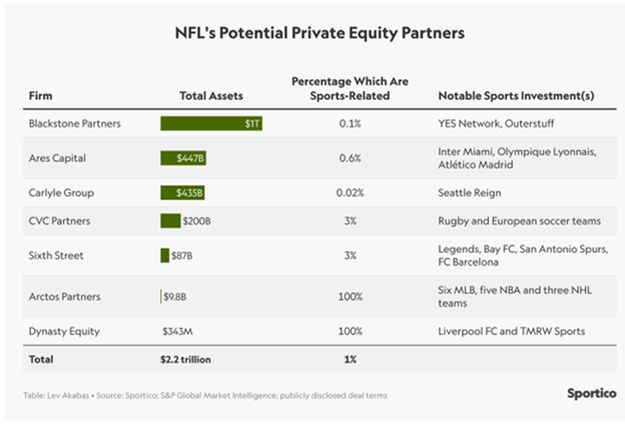Sports
Institutional Investments In Sports: Fueling Revenue And Valuation Growth – Sport – Media, Telecoms, IT, Entertainment

There was a time when ownership of a professional sports
franchise was not regarded as a serious business venture. Owning a
team, even in one of the major leagues in North America, was
regarded as more of a frolic and detour, a cool thing to do if you
had the money. No more—professional sports have become very
serious business and returns on team investments can rival or
exceed the returns from traditional asset classes. The recently
developed Ross-Arctos Sports Franchise Index (RAFSI) measures the
returns of team investments in the four major leagues in North
America (MLB, NFL, NBA and NHL):
North American professional sports franchises in the Big Five
leagues (NFL, NBA, MLB, NHL and MLS) were worth an average of
nearly $3.2 billion in 2023. One of the most recent transactions in
the NFL (the acquisition of the Washington Commanders) was valued
at more than $6 billion and NFL clubs are reported to have average
valuations that now approach or exceed $5 billion. The growth in
NFL valuations has outpaced the S&P 500 over the past 20
years.1
The exceptional growth in professional sports valuations has
been driven by dramatic increases in league media revenues. For
example, the NBA’s new $76 billion suite of national media
deals generates an average annual value (AAV) that represents a
2.6x increase over the previous national packages and could
generate an average of nearly $200 million per team, beginning in
the 2025-2026 season.
Against this backdrop of spiraling team valuations and
unprecedented demand for sports-connected assets, leagues have been
turning to institutional investors as important sources of capital
and liquidity. The NBA, NHL, MLS and MLB have developed and
implemented guidelines for private equity investments and the NFL
has just announced that it will now follow suit and allow
institutional investments. Key elements of the just-announced NFL
policy:
- Teams may sell up to 10% of their common equity to
league-approved institutional investors; the minimum deal size is
3%. - Such investments will not convey governance rights nor is
preferred equity allowed. - Investments are subject to a six-year minimum holding
period. - No fund can invest in more than six teams.
- Funds must have committed capital of $2 billion and no team
interest can account for more than 20% of a fund’s assets.

Private equity investments in sports have become increasingly
commonplace as private equity firms, sovereign wealth funds and
other asset managers have acquired interests in a number of NBA,
MLB, NHL, MLS and NWSL clubs. In addition, private credit is
beginning to play an increasingly important role in league and team
financing. The rules governing such investments vary from
league-to-league.
National Basketball Association
NBA franchise valuations have sky-rocketed over the last decade,
driven by the League’s very valuable media rights and
burgeoning international interest. Between 2010 and 2013, a number
of NBA teams changed hands and the prices ranged from $350 million
to $550 million. According to Sportico, in 2024, the average NBA
team is now valued at nearly $4 billion. That’s way beyond
Unicorn status.
The NBA’s ownership rules provide for institutional
investments in teams. Private equity funds are permitted to hold up
to a 20% stake in any franchise and each individual fund is limited
to holding interests in a maximum of five franchises. The NBA also
requires that any fund holding team interests have at least $750
million in assets and any team investment may not account for more
than 25% of the applicable fund’s assets (though the NBA has
flexibility to grant exceptions). The NBA also limits team owners
from selling more than 30% of team equity to institutional
investors.
Although the NBA once prohibited investments by governmental or
quasi-governmental authorities and sovereign wealth funds, the
League granted an exception to allow the Qatar Investment Authority
(QIA) to acquire a minority, passive stake in Monumental Sports
& Entertainment.
National Women’s Soccer League
The NWSL has seen rapidly increasing team valuations, driven by
the tidal wave of interest in women’s sports. For example,
Angel City FC recently sold a controlling stake that valued the
team at more than $250 million. The NWSL has always seen
institutional investment as a key part of their growth strategy and
private equity firms are not limited to minority investments in
teams—Bay FC is owned by Sixth Street. The NWSL allows
institutional investors to acquire minority stakes in up to three
franchises, with ownership limited to between 5-20% of each
club’s equity. Clubs may not sell more than 30% of their equity
to institutional investors, and investing funds must have capital
commitments of at least $100 million and must hold the investment
for a minimum of five years. As with other leagues, all
transactions (acquisitions and exits) are subject to league
approval and must provide the club’s controlling owner with a
right of first purchase. This requirement is like one that governs
club transactions in MLS.2 At present, the NWSL does not
allow investments from governmental or quasi-governmental
entities.3
Major League Baseball
MLB became the first North American professional sports league
to allow for institutional investment in 2019. MLB ownership rules
cap limits private equity investors to 30% of any club’s
equity, and a single fund may hold up to 15% of a team. Funds are
not limited in the number of teams they may invest in, but
investments in multiple teams are subject to a minimum five-year
holding period.
National Hockey League
The NHL’s rules on institutional ownership permit clubs to
sell up to 30% of their equity to institutional investors.
Institutional investors may hold up to 20% of a maximum of five
franchises (with each investment subject to a $20 million minimum).
NHL institutional investments are also subject to a blanket minimum
five-year holding period. The NHL does not allow active players to
invest in teams, or in funds that invest in teams.4
Major League Soccer
MLS institutional investment rules are like those in other
leagues, but also impose additional fund diversity requirements for
“qualified fund[s]”.5 Similar rules include a four-team
limit per fund, a $20 million minimum investment per team, a 20%
investment limit in each franchise and an aggregate institutional
ownership limit of 30% per franchise. For a private equity fund to
be “qualified” to invest in the league, it must have at
least $500 million in committed capital and not have concentrated
ownership. A single investor or group may hold no more than 25% of
such fund, may not invest more than 10% of the fund’s capital
into a single franchise and may not concentrate more than 25% of
the fund’s capital in MLS club investments.6 Asset managers may invest in common
equity or senior equity instruments without debt-like features.
Like other leagues, all investments in MLS clubs must be passive
and carry limited governance rights. The club’s controlling
owner must also have first negotiation rights upon the
institutional investor’s exit and drag-along rights if they
choose to sell their majority stake.
Takeaways
The demand for sports-connected assets has never been greater
and marked increases in media revenues have been driving team and
league valuations to even higher levels. While this is generally
very good news for team owners and investors, rapidly rising
valuations, coupled with strict league debt policies, create a need
for institutional investment and capital. Jerry Jones bought the
Dallas Cowboys in 1989 for $140 million; it’s hard to imagine
completing such a large transaction today without institutional
investment partners.
Private equity investments or private credit solutions can offer
a unique solution for team owners seeking to augment limited
liquidity for operations or to generate capital for technology
investments or venue improvements. Institutional investors have
become increasingly important partners in team ownership and the
capital they provide fuels future growth for the leagues and
continued growth in team valuations.
For institutional investors, there are key considerations.
First, there are substantial differences in team operating
parameters, with media market size being one of the most
significant. As the regional sports network landscape continues to
evolve, some teams in the NHL, NBA and MLB are seeing potentially
significant reductions in local media rights revenue. While these
reductions are largely offset by increases in national revenues at
the NBA and MLB, that is not the case for all leagues. Teams in
smaller media markets have more limited options for the
distribution of local media rights, and agreements with
over-the-air broadcasters generate a fraction of the revenue that
Regional Sports Network (RSN) deals used to provide for teams,
Another complicating factor for institutional investors is the
typical holding period for team and league investments. While
several of the leagues impose explicit minimum holding periods, a
more significant factor is the liquidity in the market. The limited
number of team transactions each year, coupled with relatively long
holding periods for these investments, make exits for institutional
investors more challenging. Thoughtful and creative exit strategies
need to be considered and negotiated when private equity investors
close on investments in this space. Regardless, the enviable rates
of growth in team valuations have more than made up for the
liquidity challenges.
The NFL’s announcement of its institutional investment
policy may well set off an old-fashioned land grab—with
private equity and credit investors looking for pieces of not only
some of the most iconic sports assets and brands in North America,
but some of the most valuable and profitable teams in all of
sports. The NFL’s decision to allow teams to seek investments
of up to 10% from institutional investors could generate $12-$15
billion in transactions.
Long gone are the days when team ownership was regarded as a
sideline hobby or a small family business. Today, sports teams are
sophisticated media entities with multibillion-dollar valuations,
generating returns that have been substantially out-performing
other asset classes as investments and a need for the capital
solutions provided by institutional investors. The trends driving
these dramatic increases in team valuations and the just announced
changes in the NFL’s private equity policies may well unleash
another torrent of investments in sports teams.
Footnotes
1.
https://finance.yahoo.com/quote/%5EGSPC/history?period1=946684800&period2=1719187200&interval=1mo&filter=history&frequency=1mo&includeAdjustedClose=true
2.
https://www.espn.com/nfl/story/_/id/40164039/private-equity-nfl-ownership-proposal-changes
3.
https://www.sportico.com/business/team-sales/2024/nwsl-private-equity-rules-sovereign-wealth-1234768705/
4.
https://www.espn.com/nfl/story/_/id/40164039/private-equity-nfl-ownership-proposal-changes
5.
https://www.sportico.com/business/finance/2021/mls-private-equity-rules-1234645955/
6.
https://www.sportico.com/business/finance/2021/mls-private-equity-rules-1234645955/
The content of this article is intended to provide a general
guide to the subject matter. Specialist advice should be sought
about your specific circumstances.










